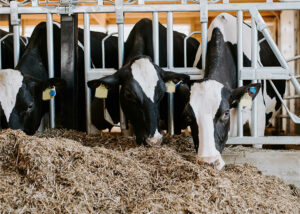On the go and want to download this PAC Fact for later?
Enzymes are proteins that catalyze or speed up reactions in the body. They are extremely critical to the breakdown of food in the stomach and intestines. There are two types of enzymes. Endogenous enzymes are those produced by the body. Exogenous enzymes are sourced outside of the body, usually from bacteria and fungi and then fed in livestock diets. Common exogenous enzymes include amylase, hemicellulase, cellulase, pectinase, xylanase, beta-glucanase and phytase.
How do exogenous enzymes work?
Exogenous enzymes help support feed utilization by the animal. They do this in two primary ways:
- They break down feed and pre-digest it. This makes feed nutrients more available to rumen microbes as well as to the animal’s digestive tract.
- They increase attachment and enzymatic activity of rumen microbes. This enables rumen microbes to break down feed that would otherwise be challenging for them to utilize.
When should exogenous enzymes be used?
Exogenous enzymes can be used when feeding moderate to low-quality feedstuffs that might be challenging for rumen microbes to break down. They also benefit high-producing cows. These animals often struggle to meet their energy requirements and enzymes can help them get more nutrients out of their diet. For similar reasons, exogenous enzymes are a good tool during periods of stress. Animals typically eat less than they normally would during these times but have higher energy requirements. Exogenous enzymes can help them get more nutrients out of the feed and support increased energy needs.
What are typical responses in cattle?
- Increased nutrient digestibility, including starch and fiber digestibility.
- Improved growth or milk production as the animal gets more energy out of the diet.
- Improved reproduction.
- Reduction in frequency, severity or duration of illness.
How can you select an exogenous enzyme that fits your herds’ needs?
- Look for a blend of enzymes. Utilizing a blend can lead to more consistent improvements in feed utilization across a variety of diets and ingredients.
- Look for data on enzyme efficacy. Data should show improvements in nutrient digestibility or health and performance parameters in both the diets and life stages of interest.
- Look for enzyme guarantees on the product label. Guarantees ensure consistent levels of enzymes are in every dose.
To learn more about our customizable solutions or to see how we can help you find the best way forward, contact us.





